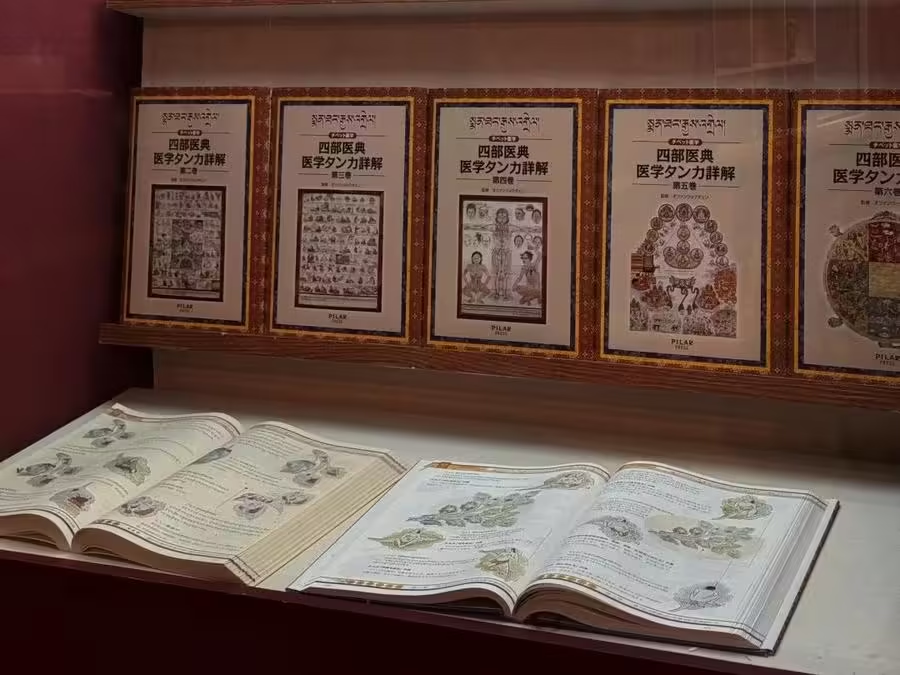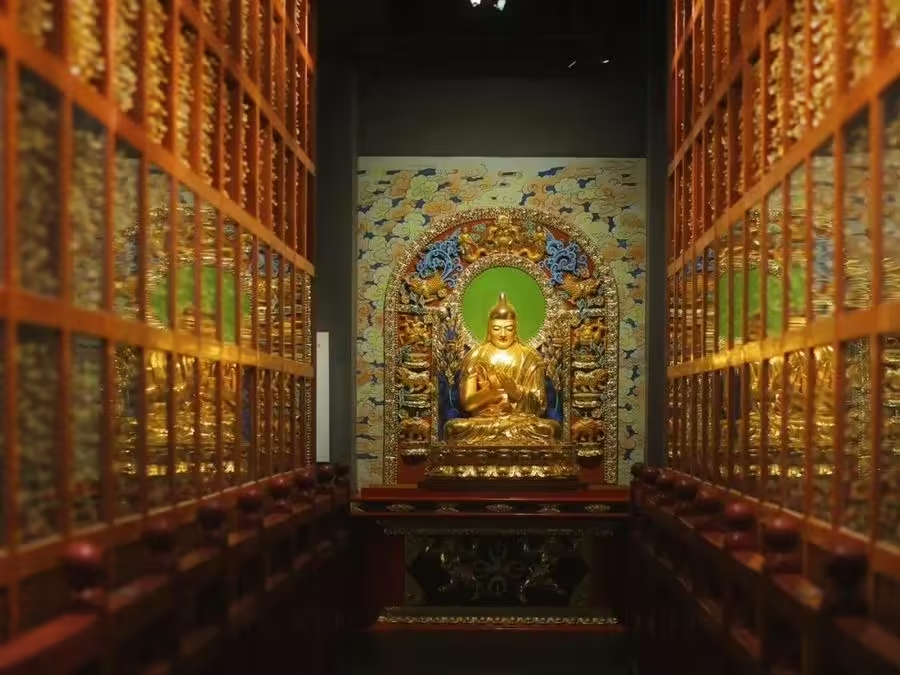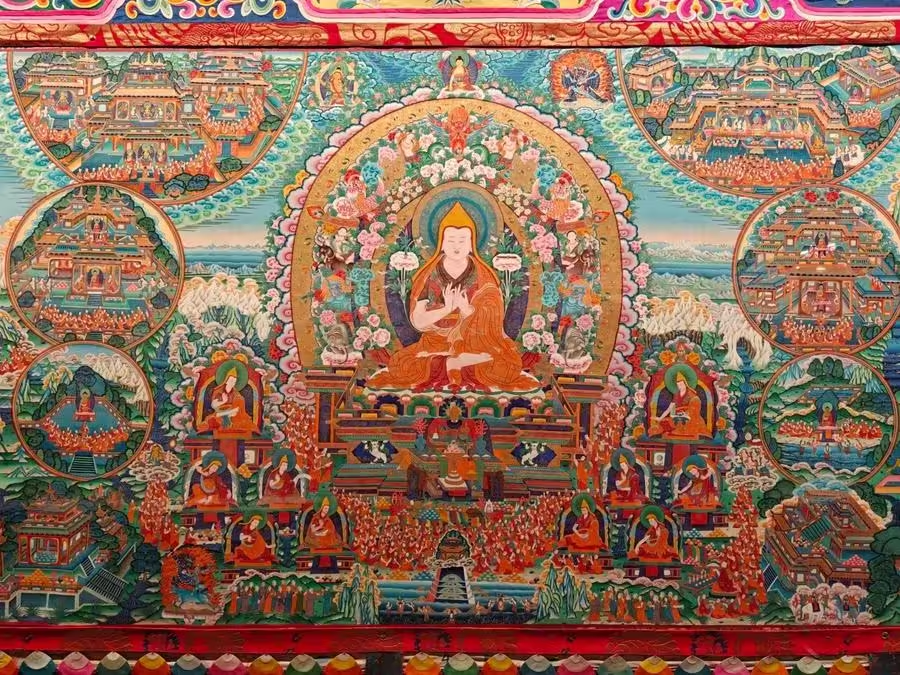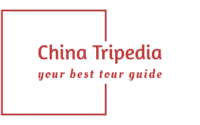The Tibetan Medicine Culture Museum (藏医药文化博物馆), also known as the Qinghai Tibetan Culture Museum (青海藏文化博物馆), officially opened on May 1, 2007. Covering an area of 12,000 square meters, the museum features six major exhibition halls, including those dedicated to the history of Tibetan medicine, ritual instruments, ancient texts, Tibetan medicine specimens, astronomical calculations, and a colorful panoramic display.
The museum houses an impressive collection of over 50,000 items, including 1,020 precious cultural relics. One of the most notable exhibits is a Thangka that holds a Guinness World Record. Measuring 618 meters long and 2.5 meters wide, this incredible artwork is meticulously painted using rare materials like gold powder, jade, and coral pigments, leaving visitors in awe of its grandeur.
Architecturally, the Tibetan Medicine Culture Museum is a magnificent structure that embodies both strength and elegance. It integrates the traditional architectural style of Tibetan culture with modern architectural art, drawing inspiration from the concept of “heavenly roundness and earthly flatness.” Surrounded by other buildings and the landscaped square of the biopharmaceutical industrial park, the museum stands as a harmonious and iconic landmark within the area.
Table of Contents
- Basic Information
- Location and Transportation
- Highlights of Tibetan Medicine Culture Museum
- Vlog about Tibetan Medicine Culture Museum
Basic Information
| Estimated Length of Tour | 2 hours |
| Ticket Price | Admission: Free Color Painting Exhibition Hall: 60 RMB |
| Opening Hours | 9.00 – 17.30; Last admission: 17.00 |
| Telephone Number | 0086-0971-5317881 |
Location and Transportation
The Tibetan Medicine Culture Museum is located at No. 36, Jing Er Road, Biological Technology Industrial Park, Chengbei District, Xining, Qinghai Province, China. To get there, you can take bus 46, 65, 72, or 538 and get off at Qinghai Tibetan Culture Museum Stop (青海藏文化博物馆站).
Highlights of Tibetan Medicine Culture Museum
Tibetan Medicine History Exhibition Hall

The Tibetan Medicine History Exhibition Hall outlines the historical trajectory of Tibetan medicine through seven distinct periods and highlights the contributions of 28 renowned Tibetan medical scholars. It features their stories, statues, and significant works, presenting an overview of the development of Tibetan medicine, which is a unique gem in the world of medicine. The exhibition introduces visitors to the rich history and medical literature of Tibetan medicine, showcasing the treatment methods of various doctors throughout history. This vibrant depiction highlights Tibetan medicine as one of the four major traditional medical systems in the world.
Mantra Instruments Exhibition Hall

The Mantra Instruments Exhibition Hall displays 80 Thangkas that are rare in the history of medicine. These Thangkas, alongside over 180 traditional surgical instruments used in Tibetan medicine, illustrate both the theoretical foundation and practical techniques of Tibetan medical practices. This innovative approach to medical education through illustrated scrolls, coupled with medical instruments used for over 1,300 years, vividly showcases how Tibetan medicine engaged in clinical surgical practices over 2,000 years ago. Photographic displays reveal that Tibetan medicine performed cranial surgeries thousands of years ago, highlighting the intelligence and wisdom of the Tibetan ancestors and demonstrating the advanced surgical techniques present in Tibetan medicine.
Tibetan Medicine Specimen Exhibition Hall

The Tibetan Medicine Specimen Exhibition Hall features over 2,000 specimens of animals, plants, and minerals found in the Qinghai-Tibet Plateau. Among these is “Zuo Tai,” known as the “King of Amrita Essence,” which is created using mercury, gold, silver, and other raw materials through special techniques. The hall also displays finished medicinal products, such as the 70 varieties of “Pearl Pills” and “Renqing Changjue,” which are included in the National Essential Drug Directory and are protected traditional Chinese medicine varieties. This exhibition not only showcases high-quality medicinal herbs featured in the Tibetan medicine classic Crystal Pearl Materia Medica but also serves as a classroom for studying the biology of the plateau. The various specimens and photographs illustrate the vibrant growth of medicinal plants in the unique natural environment of the third pole of the world – the Qinghai-Tibet Plateau.
Astronomy and Calendar Calculation Exhibition Hall

The Astronomy and Calendar Calculation Exhibition Hall utilizes a sand-based mandala, astronomical calculation tools, ancient texts, Thangkas, and statues of prominent Tibetan calendar scholars to recreate and simulate the celestial movements of the sun, moon, and stars. This hall demonstrates the role and calculation methods of astronomy in Tibetan calendar predictions, weather forecasting, and determining orientations. The science of astronomy and calendar calculation is a natural science developed by the Tibetan ancestors through their long-term production and life practices, forming an important part of Tibetan culture. With a rich historical background and abundant literature, it has distinct ethnic characteristics and is widely applied in the daily lives of the Tibetan people, significantly impacting agriculture and animal husbandry in Tibetan regions. Astronomy and calendar calculations are directly related to Tibetan medicine; through long-term practice, the Tibetan people developed the dialectical saying, “Where there is calculation, there is medicine; where there is medicine, there is calculation.” They diagnose and treat diseases and gather and process medicinal materials by understanding external climate changes and the five elements’ operational rules.
Color Painting Exhibition Hall

The Color Painting Exhibition Hall displays the Great Tibetan Color Painting Panorama of China, which has received a “World Guinness Record” certificate and is protected by national copyright. This impressive panorama spans 618 meters, covering an area of 1,500 square meters, featuring over 700 Thangkas and more than 3,000 unique embroidery patterns. The content is extensive, encompassing Tibetan views on the formation of the universe, history, religion, medicine, and cultural life, making it an encyclopedia of Tibetan culture. The Great Tibetan Color Painting Panorama of China took 27 years to plan and complete, involving more than 400 scholars, experts, and top artisans from Qinghai, Tibet, Gansu, Sichuan, and Yunnan. It was created using natural painting pigments and traditional Tibetan artistic techniques.


